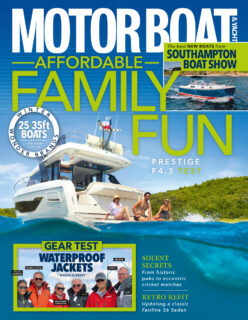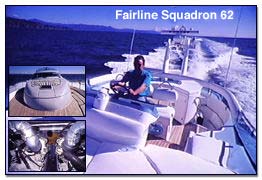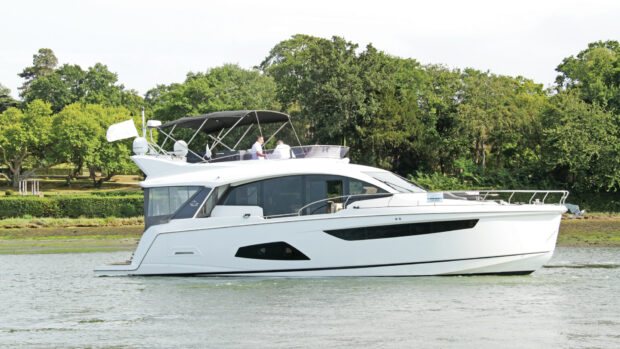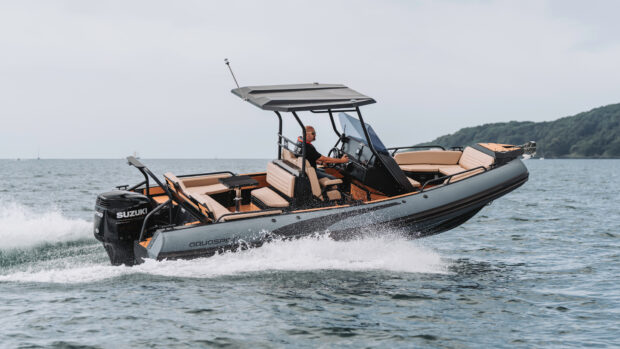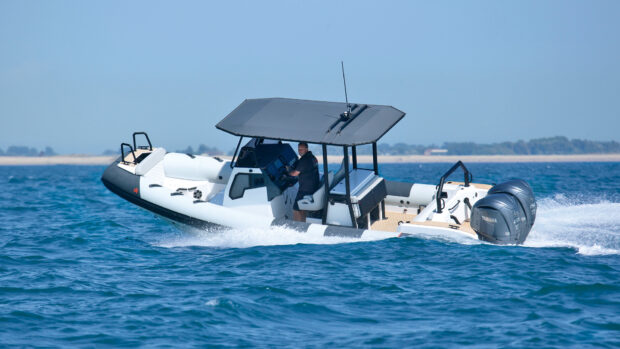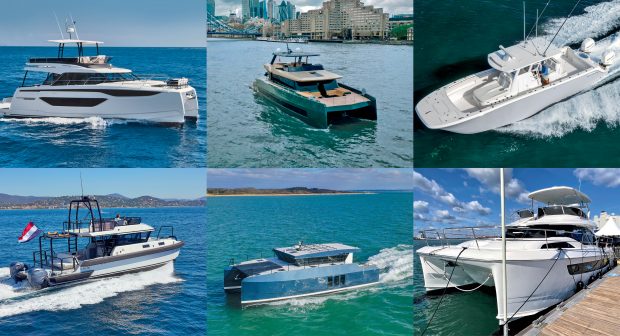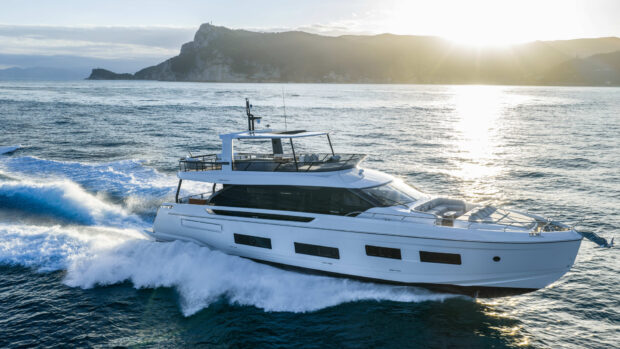With the majority of these boats heading for the sunshine, the flybridge is often the busiest and most important area of the deck.
On Deck
With the majority of these boats heading for the sunshine, the flybridge is often the busiest and most important area of the deck. As moulded flybridge steps go, these are steep and narrow for a boat this big but they are still heaps better than the near vertical offerings from many Italian builders. Up on the flybridge, my first impression was that it was compact, but this turned out to be an illusion created by the clever layout. The use of vertical masts allows Fairline to hive off the aft section for a craned-on tender. And like a number of Italian and US builders, Fairline have shifted their sunbed forward of the helm ¥ hence my initial misconception about space. Although we weren’t sunbathing, the sunbed was a perfect place to relax and watch the Italian coastline whiz by, protected from the blustery conditions by the effective windscreens.
I like the layout a lot. People seated at the helm can socialise with those on the sunbed, and because the helm is further aft, they can also talk more easily with those sat around the crescent-shaped dining area behind. The central helm is excellent ¥ by far the best I’ve had the pleasure of driving from. And how many boats this size have flybridge tender stowage? Owners treating themselves to a portable Yeoman chart plotter could even nullify the flybridge’s only shortcoming ¥ the missing chart table.
Engineering and construction
The 62’s construction is completely conventional: orthophthalic polyester resin holding together typical laminates of woven roving, chopped-strand mat and biaxial cloth, with an isophthalic gel-coat and a first layer of chopped-strand mat.
Lay-up weights (reinforcement only)
Deck 9.8oz/ft2 (3.0kg/m2)
Topsides 13.9oz/ft2 (4.3kg/m2)
Chine 36.1oz/ft2 (11.0kg/m2)
Bottom 18.0oz/ft2 (5.5kg/m2)
Keel 36.1oz/ft2 (11.0kg/m2)
For a £1 million boat, the construction and engineering installation is satisfactorily executed. There’s nothing outstanding in this department aside from the particularly fine power steering, but neither is anything lacking. Checking on the fuel filters and raw-water strainers is easy ¥ just drop down through the cockpit hatch and you find them on brackets at the rear of the engineroom. For a sporty European flybridge boat with its inevitably compact engineroom, access is fine: as the engines are handed, there’s little of routine importance that you can’t reach from between them, other than the air filters on the five outboard cylinders of the V10s.
Handling and Performance
It’s rare to helm a boat that takes you by surprise ¥ especially one designed by Bernard Olesinski. He has refined his generic hull shape to such an extent that it’s difficult to see how the overall balance of his forms could be enhanced. And good hull design is all about achieving the ideal balance of properties. We tested the boat around the waters between Portofino and Genoa. Over two days, we experienced long gentle swells about 6ft high, much shorter 5ft seas along with Force 5 winds, and flat-calm conditions. If the Squadron 62 has any handling vices, it will take bigger seas than those to uncover them. Driving upwind in the lumpy stuff reminded me that if you crave comfort in a planing powerboat there is no substitute for the length and weight of a big boat like the 62. The big surprise is the steering, which is so quick and precise that you feel as though you are helming a much smaller boat. And there does not appear to be a trade off with directional stability, as the Squadron 62 would happily maintain a ‘hands off’ course crossing the confused wake of our photo boat. Quite why it is so good is something of a mystery (see Design notes), but the 62 reinforced my belief that big boats can be fun to drive.
Engines: Twin MAN D2840 LE403
1,050hp @ 2,300rpm
V10-cylinder 18.3lt diesels
1.97:1 gearbox ratio
5-bladed props
31in diam, 43in pitch
(787mm 5 1,092mm)
98% blade area ratio
Although our noise meters indicated average levels in the saloon and cockpit, the 1,050hp MAN engines always sounded very relaxed, even flat out at 35 knots. Cruising at 30 knots is realistic, and at this Speed the flybridge is a very quiet place to pass the time. Fairline also offer two 800hp engine options, which should still nudge the 62 over that magic 30-knot frontier.
Verdict
Over the past few years, Fairline’s design team have developed an unstoppable momentum, characterised by their willingness to innovate. The avant-garde styling of their 52 shocked many when it first appeared, but the passage of time always shifts our perceptions. To my mind, when running at Speed on the water the bigger 62 looks handsome and elegant. There’s no holding back inside either, with the circular styling theme developed to its logical conclusion. Such unwavering adherence to form can sometimes undermine the function. This has not happened. Instead it has produced three exceptionally good cabins and a good saloon. The only disappointment is the galley, which feels claustrophobic for such a large boat. No disappointments up top though. The flybridge layout is very clean and simple, and the most genial and effective I have experienced on a boat this size. Fairline’s design gurus have nudged ahead of their colleagues in the engineering department. Not that I found a single thing wrong here, but the Italian contenders have been visibly upping the ante. Up to a point, the strong pound is to blame ¥ vinylester resin, double-skinned locker lids, electric oil-change pumps, and oversized guardrails and deck gear are far cheaper in lira. Nevertheless, other details cost pennies to fix ¥ colour-coded engineroom systems for instance, and labelling on the seacocks. In the conditions we experienced, the handling and Performance of the Squadron 62 was without fault. But one of the pleasures you often lose with a big boat is the fun of driving. Not so with the 62, whose wonderful turning ability adds a new level of enjoyment. This would be wasted if you were struggling to control the boat. Fortunately, there are two model helms for enthusiastic drivers of big boats. And the Squadron 62 has both of them. MBY
Design notes
The hull shape is standard fare for an Olesinski boat: deadrise angles are 43º at the bow, 18º at the transom, and around 25º amidships; the stem profile and the forefoot are normal; and the prop tunnels are the increasingly common flattened type that run out horizontally on their outboard sides. Olesinski has extended the hull aft to the rear of the bathing platform, as more waterline length equals more comfort in a seaway ¥ and, as a rule, better Performance. All this explains the impressive handling and Performance, but it doesn’t reveal why the 62 steers so well. The power steering explains why an 8st weakling can turn the wheel with so little effort. But the Speed and precision with which the boat turns are separate issues ¥ on a lot of 40-70ft (12-21m) flybridge, shaftdrive boats, no amount of wheel spinning will persuade the boat to turn quickly. In contrast, the 62 turns briskly and precisely. The tunnels are shallower than most, but this can’t be the only reason for her turning ability. Whatever it is, the Squadron 62 feels more like a 15-tonne 48-footer than the 30-tonne leviathan she is.
Data
Overall length 64ft 5in (19.63m)
Hull length 63ft 1in (19.22m)
Beam 16ft 5in (5.01m)
Displacement 28.5 tonnes light
32.6 tonnes loaded
Draught 4ft 6in (1.37m)
Air draught 18ft 10in (5.74m)
Fuel capacity 825 imp gal (3,750lt)
Water capacity 221 imp gal (1,006lt)
RPM 1,700 1,800 1,900 2,000 2,100 2,200 2,300
Speed 23.0 25.3 27.5 29.5 31.5 33.3 35.0
Trim 3.5º 4.0º 4.5º 5.0º 4.5º 4.0º 3.5º
GPH 33.9 42.2 51.5 61.6 72.6 82.7 93.5
MPG 0.68 0.60 0.53 0.48 0.43 0.40 0.37
Range 448 395 352 316 286 265 247
Range allows for 20% reserve
30% fuel, 25% water, 5 crew
3ft swell, Force 2 (for Speed trials)
Flat out 35.0 knots, 247 miles @ 2,300rpm
Cruising 30.0 knots, 300 miles @ 2,025rpm
Price from £822,003 inc VAT
Price as tested £1,091,881 inc VAT
Designers Olesinski & Fairline, 1998
RCD category B (for 14 people)
Contact Fairline Boats
Tel: 01832 273661
Fax: 01832 273432
SOUND LEVELS dB(A) Saloon Cockpit Flybridge
Cruising @ 30 knots 79 85 76
Maximum @ 35 knots 83 89 78
